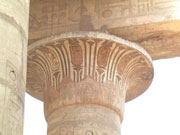TOUR NEWS - RAMESSES EGYPT - FEBRUARY 2016
The B.C. Archaeology tour of Egypt in February 2016 ran from the 7th to 28th February. The group included: Deborah Russell, Helen Fletcher, Stephanie Rigby, Liz Patten, Rachel Hole, Margaret and Jeremy Steele and Glenys Mansford. The group was led by the author (Michael Birrell) and we were given much assistance by our Egyptian guide Mohamed Aziz. I went to Cairo a few days before the group, arriving on the 4th February. I met up with our local guide Mohamed Aziz and together we went for a walk in Old Cairo - it is like something out of A Thousand and One Nights. We saw some of the beautifully restored Ottoman houses near the Al Azhar Mosque and walked up to the northern walls of the city, stopping for a coffee every few hundred metres.
I collected my group on the afternoon of the 7th February - after they checked into the hotel we had dinner at a restaurant near Giza which has a superb view of the pyramids - we saw a spectacular sunset directly behind the pyramids. The following day we began our tour. We went to Memphis (Mit Rahina), one of the ancient capitals of Egypt, where we stopped to see the ruins of the Temple of Ptah and explored the on-site museum which has some remarkable sculpture including the famous colossus of Ramesses II. We then drove to the desert plateau at Saqqara where we descended into the burial chamber of the pyramid of King Tety of the 6th Dynasty. We explored the beautiful painted reliefs of the tomb of the Vizier Mereruka. Stephanie rode a donkey to the Serapeum (the resemblance to Gertrude Bell was uncanny!). We saw the sarcophagi of the mummified Apis bulls, newly restored and now well lit. We also explored the paintings of the tomb of Ti and then walked through the Step Pyramid complex of Djoser before walking to see the tombs of Maya and Horemhab - the burial chamber of Maya is particularly stunning.
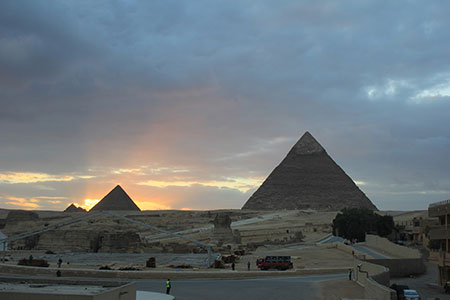 |
 |
Sunset at Giza |
Fort Qaybey in Alexandria |
On the 9th February we went to Giza. It was the end of the school holidays in Egypt and many Egyptians were there with their families (but very few foreigners). Lots of local kids wanted their photos taken with us. We all went into the Great Pyramid which looked mysterious and otherworldly as we ascended the Grand Gallery. We then saw the beautiful cedar boat of King Khufu and drove over to the pyramid of Menkaure - Helen and Liz took a horse drawn carriage for the experience. Our visit ended with a visit to the Sphinx.
We travelled from Cairo to Alexandria next morning - the desert road connecting the two cities is good and makes it a fast trip. We explored the 15th Century Fort Qaytbey which was built on the ruins of the ancient Pharos Lighthouse - many of the stones are actually part of the ancient structure. We had lunch in the Triannon Caf� (an Alexandrian institution) and then saw the Roman catacombs with their remarkable representations of Anubis. In the afternoon we went to the New Alexandria Library, an impressive piece of 20th Century architecture. We had a nice sunset from our hotel terrace where we had dinner.
 |
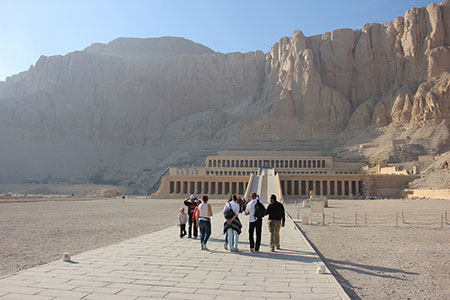 |
The Ramesseum |
Deir el Medina at Sunset |
We returned to Cairo the following morning and flew to Luxor. Once we had checked in to our hotel we went to see the magnificent Luxor Temple. Built mainly by Amenhotep III there is much to explore. The sun was setting and after visiting the temple we had a snack in a restaurant overlooking the temple.
The following day we took the ferry across the Nile where we met our bus for a day exploring the West Bank. Our first stop was at the Colossi of Memnon - there has been a lot of new excavation in the area of the mortuary temple of Amenhotep III. Two new colossi have now been set up at the Second Pylon including a stunning figure of Queen Tiye, standing statues have been erected near the sanctuary and two colossal standing statues of Amenhotep III have been re-erected near the desert edge. We then headed to Deir el Medina where we saw two painted tombs of workmen (Senedjem and Inherkau). We were able to take photos in the magnificent burial chambers (for a small gratuity) which was wonderful. Afterwards, we had a very pleasant lunch in the Amun Gezira Hotel garden which is a pleasant oasis on the west bank. We then saw the magnificent ruins of the Ramesseum, the mortuary temple of Ramesses II. It was completely devoid of other tourists (as are most of the sites at the moment) which was wonderful for us. In the afternoon we saw the painted rock-cut tombs of Rekhmire and Sennefer. We had an early dinner at the Nile Valley Hotel which has beautiful views across to Luxor Temple.
On Saturday 13th February we crossed the Nile on a small motorboat and once again saw our friendly scarf seller (who did very nicely once again, and has now retired to Aswan). We went to see Howard Carter's House which has a real atmosphere of the 1920s - we also saw the replica of Tutankhamun's tomb which has relatively recently been opened to the public. Then we went to the Valley of the Kings to see some of the royal tombs. In the afternoon we visited Deir el Bahri, the mortuary temple of Queen Hatshepsut. It was quiet at that time of day and beautiful in the afternoon light. We crossed back on the ferry as the sun was setting.
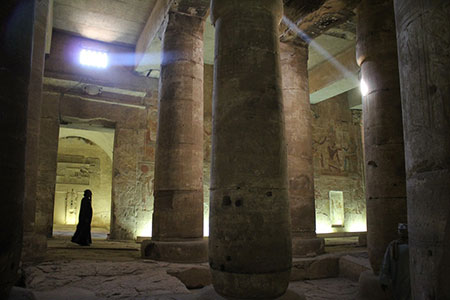 |
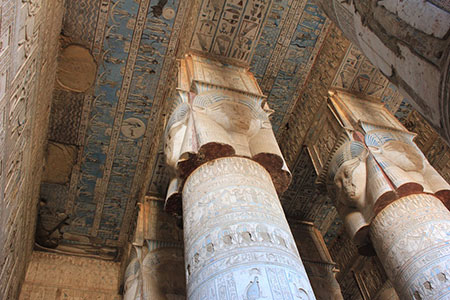 |
The stunning Temple of Abydos |
Recently restored ceiling of Dendera Temple |
The next day we went to Abydos, an archaeological site north of Luxor. The sky was very clear and we had a great view of the towering cliffs near Nag Hamadi. We had a coffee at the new tourist resort at Abydos before we went to see the magnificent memorial temple of Sety I. The temple was very quiet and we were the only tourists during our visit - the only thing we could hear was the birdsong! We had lunch at the resort (sadly empty due to lack of tourists) and then drove to the ancient site of Dendera to see the Temple of Hathor. Once again we were the only tourists in the temple! It's a very bad situation for Egypt which is clearly having its worst tourist season for quite a while.
Monday 15th February was a day off and people did their own thing in Luxor. In the afternoon we went to the grand old Edwardian Era Hotel known as the Winter Palace Hotel for a drink in the bar and some of us had dinner. The hotel was built in 1905 and Lord Carnarvon lived here during the clearance of Tutankhamun's tomb. It has a wonderful feel of a bygone age and we enjoyed the quirky service. The next day was spent at Karnak Temple - this was really the first place where we saw tourists. We took our time to explore this magnificent complex of buildings. In the afternoon we went for a felucca ride along the Nile. On the 17th February we went back to the west bank - we saw the magnificent temple of Ramesses III known as Medinet Habu. The sunlight was perfect to see the reliefs on the Tombs of the God�s Wives and the war reliefs on the north face of the temple. After a coffee we went to the Valley of the Queens which was completely empty - we had free rein to take photographs in the tombs which is certainly an upside of the lack of tourists. It was very warm in Egypt for the time of year with beautiful clear skies. In the afternoon we went to Luxor Museum to see the highlights of the excellent collection.
The following day we left Luxor after a very pleasant stay and headed south by bus. Our first top was at Edfu Temple. The temple was empty - the lack of tourists is devastating and the much loved caf� where I was expecting an Illy coffee had closed and was forlorn. Inside the temple there were no tourists at all and we could stand at the shrine and look at the reliefs as long as we wanted without the usual crush. Some tour boats are working on the Nile but we had avoided the groups by good timing. We drove on to Kom Ombo which was also devoid of tourists - the boats were yet to pull up at the temple and as a result we largely had the place to ourselves. In the afternoon we continued south to Aswan. We joined our cruise boat (the very comfortable Nubian Sea) which would be our base for a 4-night cruise on Lake Nasser. There was a stunning sunset that evening and we were treated to Nubian dancing - Steph did a fine job of joining in while the rest of us kept our heads down!
 |
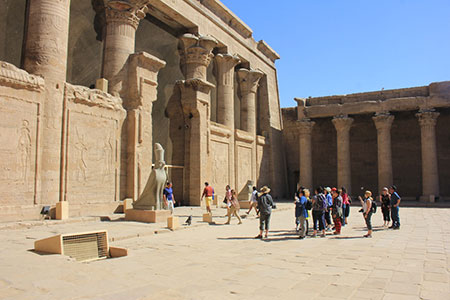 |
Relief in the temple of Medinet Habu |
Exploring Edfu |
In the morning we left the cruise boat on a small motorboat to the nearby island of Kalabsha. A number of temples had been moved here in the 1960's including the enormous Roman era Kalabasha Temple and the well preserved temple of Ramesses II known as Beit el Wali. As we were the only foreigners on the boat, and there were only about 12 Egyptian on board, we had the temples to ourselves. Lunch was on the deck as we travelled south during the afternoon - there was a beautiful sunset over the still waters of the Lake. In the evening we dropped anchor on a small island near Wadi es Sebua. The starry sky was magnificent that evening near the Tropic of Cancer.
 |
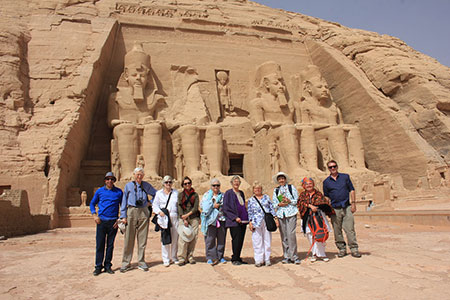 |
Sunset on Lake Nasser |
The group at Abu Simbel |
The following morning, we went ashore and visited the impressive Temple of Wadi es Sebua which had been constructed by Ramesses II - it is one of the temples which were moved during the flooding of Lake Nasser in the 1960s. Some of our group had the distinct luxury of travelling on a tractor dray. We explored the shrine and some of us took the chance to hold a juvenile crocodile - we also saw the Temple of Dakka and Maharraqa. In the afternoon our cruise boat stopped once again and we saw the beautiful painted scenes of the 18th Dynasty Temple of Amada and the shine of Derr. After dinner we returned to our rooms to discover examples of 'towel art' in our rooms using towels to create very lifelike images of ourselves.
The following morning there was a magical sunrise and the cruise boat continued on after breakfast - we arrived at Abu Simbel mid-morning to the stirring sounds of Vangelis. We anchored and went to see the two temples. Because we were there in the middle of the day we avoided the day trippers and literally had the Abu Simbel temples to ourselves - this meant I could take lots of photos inside the temple, a first! There was some free time to relax in the afternoon and some of the group went to Abu Simbel for the Sound and Light Show in the evening. It was a special occasion because it was the period (only twice a year) when the light of the morning sun shines directly into the sanctuary. The following morning (22nd February) most of us went back for the sunrise and by sharpening elbows we managed to get to the head of the queue. We saw the rays of first light strike the sanctuary and it was magical! It was surprising well managed by the Egyptian authorities. We then drove back to Aswan and after a late lunch overlooking the Nile we checked into our hotel where we would stay for 2 nights.
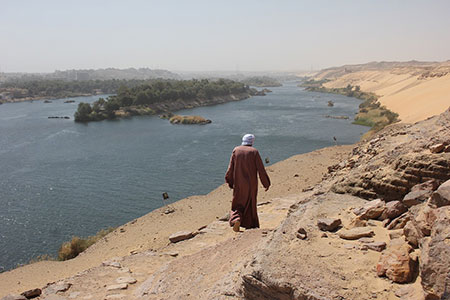 |
 |
Exploring the tombs of the Nobles at Aswan |
Sailing around Elephantine Island |
The following day was spent on a felucca (a single masted sailboat) exploring the beautiful monuments and scenery of Aswan. We crossed the Nile and then climbed up the many stone steps to the ancient necropolis where there are painted tombs of the 6th and 12th Dynasty. A Spanish mission was excavating some tombs on the terrace and invited us to look at what they were uncovering. There was a stunning view over the city. We returned to our felucca and then sailed to Kitchener's Island, the botanical garden of Aswan. The bougainvillea were out in all their glory. We stopped on the west bank and some of us walked (while others took camels) to St Simeon�s Monastery - we got an excellent guided walk round the complex. We had a late lunch at the Nubian restaurant on an island in the Nile. In the evening we went down to the Victorian Period Old Cataract Hotel and had a drink or two on the terrace.
On the 24th February we went by motorboat to the island of Philae - the Temple of Isis is one of the most picturesque in Egypt. We also saw the Aswan granite quarry where an unfinished obelisk of the New Kingdom remains stuck fast in the bedrock. We had a walk in the markets before heading to the airport for our flight to Cairo. The next day we spent time in the medieval quarter of Cairo - we went to the Citadel which was built by Saladin in the 12th Century. We then walked through the old quarter from the Khan el Khalili markets to the Beit Sihaimi, a stunning Ottoman house which has been restored. Our last day in Egypt was spent in the Cairo Museum - our hotel was close enough to enable us to walk to the Museum. It is now possible to take photos in the Cairo Museum if one buys a separate ticket - this is a much better situation after years of not being able to take photos. I have never seen the Museum so quiet - we were often the only foreigners in the galleries - let's hope that Egypt can remain stable and that people once again feel confident to come back to this wonderful country.
Michael Birrell
